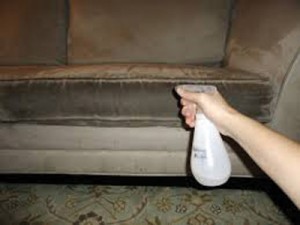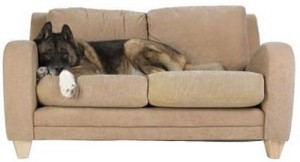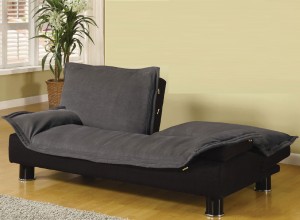Taking Care of Your Microfiber Sofa
We love our microfiber sofas and chairs, in fact I always tell people that it is just about the best, and most practical upholstery fabric for our climate, and casual lifestyles. Microfiber is a great fabric choice for down here because it resists deterioration even when exposed to mildew, sunlight, water and insects – as well as having many other wonderful qualities.
Nowadays we can find microfiber fabrics in an exciting array of designs and textures. There is even a polished version that looks like distressed leather. The colours are great too – they are much more vibrant than with natural fabrics like cotton or linen. The ‘hand’ or feel, is soft and luxurious and it has a unique texture that accentuates the colour’s depth and contrast, making it an excellent upholstery choice.
The production of “microfibers” (those less than 0.7 denier) was begun back in the 1950’s with rather limited applications. However Japan developed new techniques to produce continuous length, ultra-fine fibers in the 1960’s and the resulting Ultra suede arrived on the market a decade later. After that microfiber’s use greatly expanded, offering animal-free imitation suede (leather) that was cheaper, lighter and easier to clean and sew than leather, as well as being water repellent and hardwearing. Its luxurious appearance and feel made it a popular choice for clothing and upholstery, although it is also widely used today for cleaning cloths and mops, insulation and industrial filters, amongst other things.
The superior stain resistance and durability of microfiber fabric means that your sofa will be able to withstand the rigors of daily use by active kids, pets – and renters! In order to keep your sofa looking its best, some simple care is required.
Keep it clean. Prevent stains as much as possible by cleaning up crumbs, dust, and dirt. Vacuuming regularly with a brush attachment will make this quick and easy. If you have pets, you may need a sticky lint roller to get all of the hair. How often you need to do this will vary depending on how much you use your furniture and how many people and pets you have in your house.
 Clean spills immediately. Microfiber fabric is stain resistant, so small spills will bead up instead of soaking into the fabric. This gives you the chance to get some paper towels and soak up the spill before it stains. Soak up as much moisture as possible by dabbing at the area – not rubbing. Wait until the material has dried before sitting on it again.
Clean spills immediately. Microfiber fabric is stain resistant, so small spills will bead up instead of soaking into the fabric. This gives you the chance to get some paper towels and soak up the spill before it stains. Soak up as much moisture as possible by dabbing at the area – not rubbing. Wait until the material has dried before sitting on it again.
Quick Clean ups. You can do a quick spot-clean using a damp sponge. A sponge squeezed free of excess water can be used to gently rub a light stain out of the microfiber fabric. If necessary, a drop of dish soap can be used to help lift the stain. Allow the couch to air dry when done. Do not make it wet, as this can leave water marks. If the nap settles, just use the toothbrush trick. You can also try lightly spraying Rubbing Alcohol (Isopropyl Alcohol) on those arm or head rests and wiping with a clean sponge to remove body grease and other staining.
Spot Clean. If a stain sets, try spraying some rubbing alcohol over the stained area and dab with a clean white cloth or sponge towards the center of the stain so you do not spread it, then allow it to dry. The alcohol is a great stain-fighting ally, because it will not penetrate the fabric and it evaporates quickly. (But always test on an inconspicuous area first.) If the fabric feels matted after it dries use a toothbrush in a circular motion to raise the nap.
However, we all know that here are times when your sofa may need some special TLC. Here are some specific spot cleaning tips:
 Pet pee. Blot up pet urine stains with a soft cloth until there is no visible liquid pooling on the surface of the microfiber. Use a second cloth to blot the area with vinegar – remember, do not rub. Sprinkle with baking soda and allow the area of the pet stain to dry. Vacuum the baking soda with your vacuum’s brush tool. Rubbing alcohol is also a great disinfectant and could be used here too as a final clean if necessary.
Pet pee. Blot up pet urine stains with a soft cloth until there is no visible liquid pooling on the surface of the microfiber. Use a second cloth to blot the area with vinegar – remember, do not rub. Sprinkle with baking soda and allow the area of the pet stain to dry. Vacuum the baking soda with your vacuum’s brush tool. Rubbing alcohol is also a great disinfectant and could be used here too as a final clean if necessary.
Marker and Ink. Remove marker and ink with a cotton ball or Q-Tip and rubbing alcohol. Apply just enough to the cotton ball to dampen it – do not over saturate the cotton. Blot or ‘stroke’ the ink or marker stain until the stain is removed. Take care not to extend the stain, so always work from the outside in.
Food Spills. Lift any excess food with a dull knife-edge. Blot off excess food with a cloth dampened with warm water. If the spill has dried, you may be able to remove the food completely by lightly brushing off the dried food with a clean, dry soft-bristled brush.
Candle wax. Lift as much off as you can. Then place a paper towel or terry cloth over the spill and quickly run a hot iron over it, after testing in an inconspicuous area first!
Grease and Oil Stains. Blot the area gently with a paper towel, allowing it to soak up as much of the stain as possible, and sprinkle baking soda over the area. Allow it to sit and absorb the oil for about 15 minutes. Vacuum off the baking soda with the brush attachment. If still visible, spray rubbing alcohol over the area and dab it into the stain with a clean, white cloth, and allow to dry. Use a toothbrush to re-set the nap.
Chewing Gum. Put a bag of ice over chewing gum until it hardens, then peel it off.
NOTE: Always remember the following when cleaning your furniture:- Test in an inconspicuous area first; Use a white cleaning cloth – and keep it clean or you can spread the stain and Do not over-wet . We are all about a low maintenance lifestyle here, so microfiber is a no-brainer.
Keep it simple, keep it clean and keep it beautiful!
Until next time…
Shelagh Duncan
Royal Palm Interiors – Uvita – 2743-8323
www.royalpalminteriors.com
Like us on facebook.com/RoyalPalmInteriors


